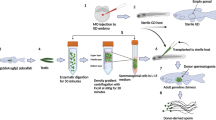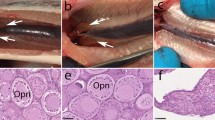Abstract
Haploids and double haploids are important resources for studying recessive traits and have large impacts on crop breeding1, but natural haploids are rare in animals. Mammalian haploids are restricted to germline cells and are occasionally found in tumours with massive chromosome loss2,3. Recent success in establishing haploid embryonic stem (ES) cells in medaka fish4 and mice5,6 raised the possibility of using engineered mammalian haploid cells in genetic studies. However, the availability and functional characterization of mammalian haploid ES cells are still limited. Here we show that mouse androgenetic haploid ES (ahES) cell lines can be established by transferring sperm into an enucleated oocyte. The ahES cells maintain haploidy and stable growth over 30 passages, express pluripotent markers, possess the ability to differentiate into all three germ layers in vitro and in vivo, and contribute to germlines of chimaeras when injected into blastocysts. Although epigenetically distinct from sperm cells, the ahES cells can produce viable and fertile progenies after intracytoplasmic injection into mature oocytes. The oocyte-injection procedure can also produce viable transgenic mice from genetically engineered ahES cells. Our findings show the developmental pluripotency of androgenentic haploids and provide a new tool to quickly produce genetic models for recessive traits. They may also shed new light on assisted reproduction.
This is a preview of subscription content, access via your institution
Access options
Subscribe to this journal
Receive 51 print issues and online access
$199.00 per year
only $3.90 per issue
Buy this article
- Purchase on Springer Link
- Instant access to full article PDF
Prices may be subject to local taxes which are calculated during checkout



Similar content being viewed by others
References
Germanà, M. A. Gametic embryogenesis and haploid technology as valuable support to plant breeding. Plant Cell Rep. 30, 839–857 (2011)
Carette, J. E. et al. Haploid genetic screens in human cells identify host factors used by pathogens. Science 326, 1231–1235 (2009)
Kaufman, M. H., Robertson, E. J., Handyside, A. H. & Evans, M. J. Establishment of pluripotential cell lines from haploid mouse embryos. J. Embryol. Exp. Morphol. 73, 249–261 (1983)
Yi, M., Hong, N. & Hong, Y. Generation of medaka fish haploid embryonic stem cells. Science 326, 430–433 (2009)
Leeb, M. & Wutz, A. Derivation of haploid embryonic stem cells from mouse embryos. Nature 479, 131–134 (2011)
Elling, U. et al. Forward and reverse genetics through derivation of haploid mouse embryonic stem cells. Cell Stem Cell 9, 563–574 (2011)
Zhou, Q. et al. Generation of fertile cloned rats by regulating oocyte activation. Science 302, 1179 (2003)
Yanagimachi, R., Wakayama, T., Perry, A. C. F., Zuccotti, M. & Johnson, K. R. Full-term development of mice from enucleated oocytes injected with cumulus cell nuclei. Nature 394, 369–374 (1998)
Ying, Q. L. et al. The ground state of embryonic stem cell self-renewal. Nature 453, 519–523 (2008)
Yoshimizu, T. et al. Germline-specific expression of the Oct-4/green fluorescent protein (GFP) transgene in mice. Dev. Growth Differ. 41, 675–684 (1999)
Tarkowki, A. K. In vitro development of haploid mouse embryos produced by bisection of one-cell fertilized eggs. J. Embryol. Exp. Morphol. 38, 187–202 (1977)
Latham, K. E., Patel, B., Bautista, F. D. & Hawes, S. M. Effects of X chromosome number and parental origin on X-linked gene expression in preimplantation mouse embryos. Biol. Reprod. 63, 64–73 (2000)
Yang, H. et al. Generation of genetically modified mice by oocyte injection of androgenetic haploid embryonic stem cells. Cell 149, 605–617 (2012)
Nichols, J. & Smith, A. Naive and primed pluripotent states. Cell Stem Cell 4, 487–492 (2009)
Brons, I. G. et al. Derivation of pluripotent epiblast stem cells from mammalian embryos. Nature 448, 191–195 (2007)
Tesar, P. J. et al. New cell lines from mouse epiblast share defining features with human embryonic stem cells. Nature 448, 196–199 (2007)
Maruotti, J. et al. Nuclear transfer-derived epiblast stem cells are transcriptionally and epigenetically distinguishable from their fertilized-derived counterparts. Stem Cells 28, 743–752 (2010)
Kimura, Y. & Yanagimachi, R. Mouse oocytes injected with testicular spermatozoa or round spermatids can develop into normal offspring. Development 121, 2397–2405 (1995)
Loren, J. & Lacham-Kaplan, O. The employment of strontium to activate mouse oocytes: effects on spermatid-injection outcome. Reproduction 131, 259–267 (2006)
Mayer, W., Niveleau, A., Walter, J., Fundele, R. & Haaf, T. Demethylation of the zygotic paternal genome. Nature 403, 501–502 (2000)
Santos, F., Hendrich, B., Reik, W. & Dean, W. Dynamic reprogramming of DNA methylation in the early mouse embryo. Dev. Biol. 241, 172–182 (2002)
Surani, M. A., Barton, S. C. & Norris, M. L. Development of reconstituted mouse eggs suggests imprinting of the genome during gametogenesis. Nature 308, 548–550 (1984)
Surani, M. A. et al. Genome imprinting and development in the mouse. Dev. (Suppl.). 89–98 (1990)
McGrath, J. & Solter, D. Completion of mouse embryogenesis requires both the maternal and paternal genomes. Cell 37, 179–183 (1984)
Tsai, T. F., Jiang, Y. H., Bressler, J., Armstrong, D. & Beaudet, A. L. Paternal deletion from Snrpn to Ube3a in the mouse causes hypotonia, growth retardation and partial lethality and provides evidence for a gene contributing to Prader-Willi syndrome. Hum. Mol. Genet. 8, 1357–1364 (1999)
Kono, T. et al. Birth of parthenogenetic mice that can develop to adulthood. Nature 428, 860–864 (2004)
Tachibana, M. et al. Generation of chimeric rhesus monkeys. Cell 148, 285–295 (2012)
Mann, J. R., Gadi, I., Harbison, M. L., Abbondanzo, S. J. & Stewart, C. L. Androgenetic mouse embryonic stem cells are pluripotent and cause skeletal defects in chimeras: implications for genetic imprinting. Cell 62, 251–260 (1990)
Zhao, X. Y. et al. Viable fertile mice generated from fully pluripotent iPS cells derived from adult somatic cells. Stem Cell Rev. 6, 390–397 (2010)
Ying, Q. L. & Smith, A. G. Defined conditions for neural commitment and differentiation. Methods Enzymol. 365, 327–341 (2003)
Sheng, C. et al. Direct reprogramming of Sertoli cells into multipotent neural stem cells by defined factors. Cell Res. 22, 208–218 (2012)
Acknowledgements
We thank all members of the Group of Reproductive Engineering for discussion and help. This study was supported by a grant from the National Science Foundation of China 90919060 (to Q.Z.) and the China National Basic Research Program 2012CBA01300 (to Q.Z.), and a grant from the Strategic Priority Research Program of the Chinese Academy of Sciences XDA01020100 (to Q.Z.). We thank Fluidigm Corporation for their support in the utilization of BioMark HD system. We thank Eppendorf and Leica for supporting the facility.
Author information
Authors and Affiliations
Contributions
Q.Z. and X.-Y.Z. designed the experiments;; W.L., L.S., H.W., M.D., M.W., L.S., C.F., T.L., X.L., L.W., Q.-Y.Z. and C.S. performed experiments; Q.Z, X.-Y.Z, X.-J.W., G.-Z.L., W.L., H.-J.W. and L.L. analysed data; Q.Z., X.-Y.Z., Z.L., and L.W..supervised experiments; W.L., L.S., H.W. and M.D. contributed to part of the Methods. Q.Z., X.-Y.Z., X.-J.W. and W.L. wrote the paper.
Corresponding authors
Ethics declarations
Competing interests
The authors declare no competing financial interests.
Supplementary information
Supplementary Information
This file contains Supplementary Figures 1-15, Supplementary Tables 1-6 and an additional reference. (PDF 1628 kb)
Rights and permissions
About this article
Cite this article
Li, W., Shuai, L., Wan, H. et al. Androgenetic haploid embryonic stem cells produce live transgenic mice. Nature 490, 407–411 (2012). https://doi.org/10.1038/nature11435
Received:
Accepted:
Published:
Issue Date:
DOI: https://doi.org/10.1038/nature11435
This article is cited by
-
Epigenetic integrity of paternal imprints enhances the developmental potential of androgenetic haploid embryonic stem cells
Protein & Cell (2022)
-
Genomic imprinting in mouse blastocysts is predominantly associated with H3K27me3
Nature Communications (2021)
-
Double sperm cloning (DSC) is a promising strategy in mammalian genetic engineering and stem cell research
Stem Cell Research & Therapy (2020)
-
Dosage effect of multiple genes accounts for multisystem disorder of myotonic dystrophy type 1
Cell Research (2020)
-
Temporal regulation of prenatal embryonic development by paternal imprinted loci
Science China Life Sciences (2020)
Comments
By submitting a comment you agree to abide by our Terms and Community Guidelines. If you find something abusive or that does not comply with our terms or guidelines please flag it as inappropriate.



